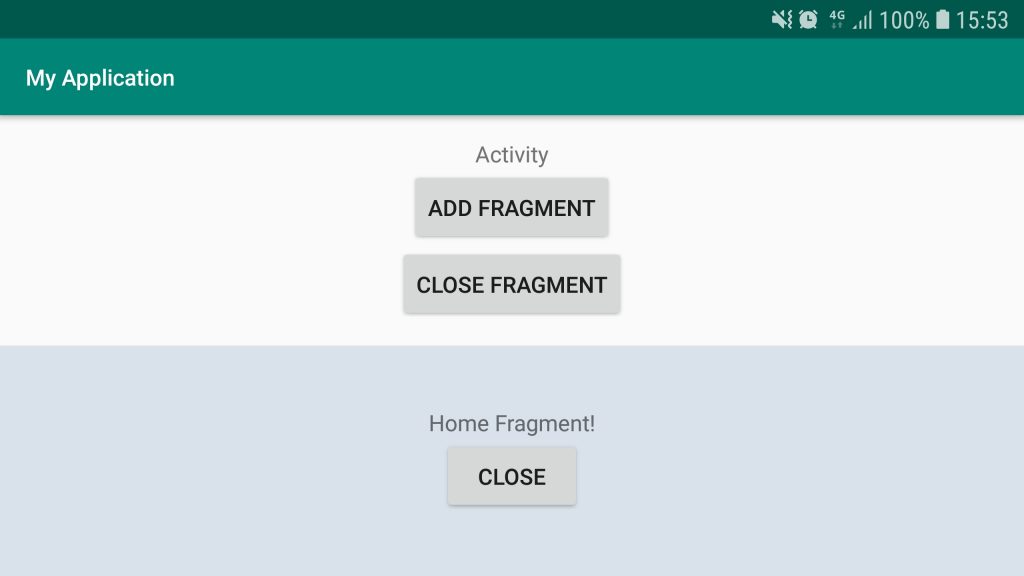เมื่อเปิดแอพจะสร้าง fragment ขึ้นมาด้วยเลย 1 อัน
ถ้าจะสร้าง fragment เพิ่มก็กดปุ่ม ADD FRAGMENT กด 1 ครั้งก็สร้าง fragment ขึ้่นมา 1 อัน (fragment ที่สร้างใหม่จะอยู่ด้านบน)
ถ้าจะลบ fragment ก็กดปุ่ม CLOSE FRAGMENT กด 1 ครั้งก็ลบ fragment ออกไป 1 อัน
หรือกด Back 1 ครั้งก็ลบ fragment ออกไป 1 อัน

สร้าง Fragment ขึ้นมาใหม่ชื่อ HomeFragment
ไฟล์ที่เกี่ยวข้อง
- activity_main.xml
- MainActivity.java
- fragment_home.xml
- HomeFragment.java
activity_main.xml
<?xml version="1.0" encoding="utf-8"?>
<LinearLayout xmlns:android="http://schemas.android.com/apk/res/android"
xmlns:tools="http://schemas.android.com/tools"
android:layout_width="match_parent"
android:layout_height="match_parent"
android:orientation="vertical"
tools:context=".MainActivity">
<LinearLayout
android:layout_width="match_parent"
android:layout_height="0dp"
android:layout_weight="1"
android:gravity="center"
android:orientation="vertical">
<TextView
android:layout_width="wrap_content"
android:layout_height="wrap_content"
android:text="Activity" />
<Button
android:id="@+id/btn_add_fragment"
android:layout_width="wrap_content"
android:layout_height="wrap_content"
android:text="Add Fragment" />
<Button
android:id="@+id/btn_remove_fragment"
android:layout_width="wrap_content"
android:layout_height="wrap_content"
android:text="Close Fragment" />
</LinearLayout>
<FrameLayout
android:id="@+id/layout_fragment_container"
android:layout_width="match_parent"
android:layout_height="0dp"
android:layout_weight="1"
android:background="#d9e1ea" />
</LinearLayout>
MainActivity.java
package com.phaisarn.myapplication;
import androidx.appcompat.app.AppCompatActivity;
import androidx.fragment.app.Fragment;
import android.os.Bundle;
import android.view.View;
import android.widget.Button;
public class MainActivity extends AppCompatActivity {
private static final String TAG_HOME_FRAGMENT = "tag_home_fragment";
@Override
protected void onCreate(Bundle savedInstanceState) {
super.onCreate(savedInstanceState);
setContentView(R.layout.activity_main);
if (savedInstanceState == null) {
getSupportFragmentManager()
.beginTransaction()
.replace(R.id.layout_fragment_container,
HomeFragment.newInstance(),
TAG_HOME_FRAGMENT)
.addToBackStack(null)
.commit();
}
Button btnAddFragment = findViewById(R.id.btn_add_fragment);
Button btnRemoveFragment = findViewById(R.id.btn_remove_fragment);
btnAddFragment.setOnClickListener(onAddFragmentClickListener);
btnRemoveFragment.setOnClickListener(onRemoveFragmentClickListener);
}
private View.OnClickListener onAddFragmentClickListener = new View.OnClickListener() {
@Override
public void onClick(View v) {
// คำสั่งเพิ่ม Fragment ลงบน ViewGroup
getSupportFragmentManager()
.beginTransaction()
.replace(R.id.layout_fragment_container,
HomeFragment.newInstance(),
TAG_HOME_FRAGMENT)
.addToBackStack(null)
.commit();
}
};
private View.OnClickListener onRemoveFragmentClickListener = new View.OnClickListener() {
@Override
public void onClick(View v) {
// คำสั่งลบ Fragment ที่อยู่บน ViewGroup
Fragment fragment = getSupportFragmentManager().findFragmentByTag(TAG_HOME_FRAGMENT);
if (fragment != null) {
getSupportFragmentManager().popBackStack();
}
}
};
}
fragment_home.xml
<?xml version="1.0" encoding="utf-8"?>
<LinearLayout xmlns:android="http://schemas.android.com/apk/res/android"
android:layout_width="match_parent"
android:layout_height="match_parent"
android:gravity="center"
android:orientation="vertical">
<TextView
android:layout_width="wrap_content"
android:layout_height="wrap_content"
android:text="Home Fragment!" />
<Button
android:id="@+id/btn_close"
android:layout_width="wrap_content"
android:layout_height="wrap_content"
android:text="Close" />
</LinearLayout>
HomeFragment.java
package com.phaisarn.myapplication;
import android.os.Bundle;
import androidx.annotation.Nullable;
import androidx.fragment.app.Fragment;
import android.view.LayoutInflater;
import android.view.View;
import android.view.ViewGroup;
import android.widget.Button;
/**
* A simple {@link Fragment} subclass.
*/
public class HomeFragment extends Fragment {
public HomeFragment() {
// Required empty public constructor
}
public static HomeFragment newInstance() {
return new HomeFragment();
}
@Override
public View onCreateView(LayoutInflater inflater, ViewGroup container,
Bundle savedInstanceState) {
// Inflate the layout for this fragment
return inflater.inflate(R.layout.fragment_home, container, false);
}
@Override
public void onViewCreated(View view, @Nullable Bundle savedInstanceState) {
super.onViewCreated(view, savedInstanceState);
Button btnClose = view.findViewById(R.id.btn_close);
btnClose.setOnClickListener(onCloseClickListener);
}
private View.OnClickListener onCloseClickListener = new View.OnClickListener() {
@Override
public void onClick(View v) {
getFragmentManager().popBackStack();
}
};
}
